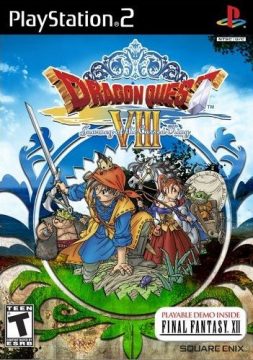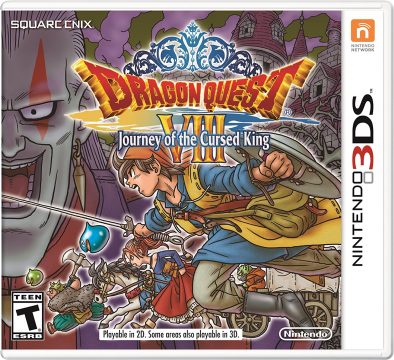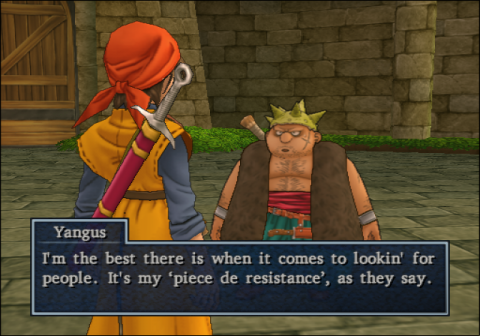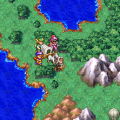- Dragon Quest (Introduction)
- Dragon Quest
- Dragon Quest II
- Dragon Quest III
- Dragon Quest IV: The Chapters of the Chosen
- Dragon Quest V: Hand of the Heavenly Bride
- Dragon Quest VI: Realms of Revelation
- Dragon Quest VII: Fragments of the Forgotten Past
- Dragon Warrior VIII: Journey of the Cursed King
- Dragon Quest XI: Echoes of an Elusive Age
- Slime Mori Mori Dragon Quest
- Dragon Quest Heroes: Rocket Slime
- Slime Mori Mori Dragon Quest 3
- Dragon Quest Heroes
- Dragon Quest Heroes II
Dragon Quest VIII was released for the PlayStation 2 about four years after its predecessor, just a little less time than the gaps between the sixth and seventh installments. While, again, a bit of a latecomer compared to the prolific Final Fantasy series, this particular entry wasn’t nearly as dated upon release. The development was handled by Level-5, who had cut their teeth on other RPGs like Dark Cloud and Rogue Galaxy, and gave the series a much needed visual overhaul in the process.
The prologue of Dragon Quest VIII begins in the small kingdom of Trodain. A malicious jester named Dhoulmagus has stolen a precious magical artifact and calls a plague upon the kingdom. The castle is overrun with vines, the king is turned into a little ghoul, the princess is turned into a horse, and nearly everyone in the castle has become cursed. The only survivor is a young soldier, a hero who is mysteriously unharmed. These three leave the land in order to pursue Dhoulmagus, not only to take revenge and stop him from doing even more damage, but to find a way to turn their kingdom – and bodies – back to normal.
Characters
Hero
The Hero is one of the only members of the Trodain Kingdom that wasn’t affected by the curse. Naturally, the reasons for your survival play a huge role in plot, at least later in the game. Like most heroes, he’s a pretty balanced character, who specializes in swords, spears and boomerangs, and has some decent magic. Somewhat officially known as “Eight”.
Yangus
Yangus may look like a tough brute, but he’s really a big teddy bear. When he first met up the team, he tried to extort some money out of them, only to be left dangling off the side of a cliff. The hero, ever compassionate, spares his life, and Yangus joins out of gratitude, calling him “guv” from there on in. He’s a gruff fellow who speaks with a Cockney accent (in the English versions, anyway), and mostly concentrates on physical attacks. His catchphrase is “Cor blimey!”, usually said whenever he’s surprised by King Trode’s sudden appearances.
Jessica
The daughter of a rich family, Jessica seeks to take revenge on Dhoulmagus, who killed her brother in cold blood. She’s mostly skilled with whips and magical spells, although her biggest asset is obviously her sex appeal. Her looks can randomly charm foes if you build them up enough, and she can even execute a “puff puff” on enemies to make them swoon. There are also a number of fetish-y costumes that you can dress her up as – she’s the only character that changes appearance based on what armor you equip her with.
Angelo / Kukule
A member of the Knight’s Templar, Angelo concentrates more on boozing and flirting than doing his duties. But after Dhoulmagus sets his abbey on fire and kills his master, he shapes up and joins your party, also motivated for revenge. He’s another well rounded character, with both powerful melee attacks and strong magic. His Japanese name is absurd, so they changed it for the English version.
King Trode
Poor King Trode. He’s cursed with the form of a troll, and thus is abhorred by pretty much everyone. He never actually fights, but instead just tags along, keeping watch over his daughter Medea (in horse form) and moving the plot along. However, he does help create the Alchemy Pot, and gives you his comments on your battle performance.
Morrie / Morris
The header of the Monster Arena, he’s an amusing enough of a character that he was made playable in the 3DS port.
Dragon Quest VIII isn’t the first 3D game in the series – technically that honor goes to the PlayStation 2 remake of the fifth entry – but it makes that port looks cheap by comparison. The whole game is like being in full control of one of the best looking anime ever created, with amazing cel-shaded character models that bring out the best in Toriyama artwork, and gorgeous castles that are stunning works of polygonal architecture. Even though it was published in 2004, it looks magnificent, years later. The camera has moved from an overhead view to a behind-the-back perspective, further immersing you in the game’s world. For the first time, the world of Dragon Quest wasn’t simply just a series of box-like characters moving through tile-based corridors, but instead a fully developed, leaving, breathing world.
It also solves an issue that JRPGs have had for awhile. Back in the early days of Dragon Quest, the game world seemed absolutely sprawling compared to other games released circa 1987. When you first stepped outside of the castle and ventured off to fight the DragonLord, it would take many hours to slowly map your way over to the other side of the map. Of course, as RPGs became more complex, the worlds became larger and larger, but much of the adventure felt like it was missing something. Not that there was anything inherently bad about it, but the availability of maps and the generally faster paced of the later games meant the worlds didn’t really feel as epic as before. The later DQ games tried to fix this with the multiple worlds seen in DQVI and DQVII but that just seemed to bloat things out.
One of Dragon Quest VIII‘s most impressive feats is making the overworld feel grandiose again. It’s a huge, sprawling field of green, one of the most amazing seen in any Japanese RPG at the time, where you can see almost anything in the distance. The map isn’t quite as large as some open-ended Western RPGs at the time, like, say, Oblivion, but it’s still pretty gigantic. It’s structured well enough, so that you can follow the path and reach your destination, or spend hours exploring the back roads and hidden nooks for treasures. One of the downsides to this is that only the main character is visible on the map – technically you’re traveling with caravan, and you can hear the horse clopping as you walk around the overworld, but it only pops up in cutscenes. Perhaps having your entire party follow you would’ve put too much of a strain on the system, or made the view too cluttered.
Later in the game, you can even ride a Sabrecat/Killer Panther (the same kind as in Dragon Quest V) and completely tear through the landscape, plus there’s the usual ship to explore the seas, as well as a bird to take to the skies. Also, for the first time since Dragon Quest V, the day/night cycle has returned. On the negative side, the dungeons are often rather simple, and are missing the “maze-like” feeling of the previous games. You can find maps for them in the PlayStation 2 version, but they’re displayed automatically on the 3DS.
The battle system also benefits hugely from the graphical upgrade. For the first time, you actually see your enemies and characters attack each other. All of the goofy attacks by the enemies are a lot more amusing when you see them, as opposed to just reading the text. Although this makes battles run by slower, it makes each fight far more engaging that the simple text narration and sound effects, although those are there too. To counterbalance this, the enemy encounter rate has significantly dropped, so combat is rarely overwhelming. This is also the first game where you can finally target individual enemies instead of groups – it took them long enough! All characters also have the ability to “Psyche Up”, an expansion of a skill from the previous games. Psyching up will sacrifice a character’s turn in order to strengthen themselves, which is referred to as “tension”. Their tension rises exponentially every turn you Psyche-Up, and dissipates whenever you take another action.
The idea is that you can do more damage if you psyche up for four turns then attack, as opposed to simply fighting every turn. It adds a lot more strategy to the battles, and it carefully balances the risk vs. reward mechanic without becoming overpowered, because many bosses have the ability to reduce a character’s tension completely. At a certain level, you can also reach a state of Super High Tension where you freak out Dragon Ball Z-style and turn purple in the process.
Still, in as many steps forward that Dragon Quest VIII takes, it falls a few steps back on other issues. There’s no real narrative hook here – Dragon Quest IV has the chapter system, Dragon Quest V has the “follow hero through his life” structure, Dragon Quest VI has the dream world and Dragon Quest VII has time travel. Dragon Quest VIII is much more simplistic – you’re a small band of travelers out to defeat evil, and little more. The plot eventually kicks into gear about midway through the game – as to be expected, Dhoulmagus is far from the final bad guy – but if you’re expecting anything revelatory, Dragon Quest VIII doesn’t really offer it. The quality of the vignettes isn’t quite as emotional affecting some of the previous games, though there are still some decent stories in there. Dhoulmagus plays a greater antagonistic role than most previous DQ baddies and his gleeful violence creates waves of despair for both the the player characters and the rest of the game world.
Additionally, there are only four human characters to play as (at least in the PS2 release), which is disappointing considering the wider roles offered in other games, though it does have the best cast of characters since DQIV. The pacing also feels a little off. While the game isn’t nearly as drawn out as Dragon Quest VII, the large 3D environments, both in the overworld and the dungeons, take much longer the traverse than the simple 2D maps of old. Add in the longer battles and added load times, and it feels like you’re spending even more time walking around and fighting, and less time advancing the story.
What it lacks in story is made up for in personality – due to both the expressive character models and outstanding writing, this is easily the most memorable cast of characters seen in a Dragon Quest game. They converse amongst each other more often, and using the Talk option to learn about current events is much more constructive than it was in DQVII. Furthermore, the English version of the game features some absolutely outstanding voice acting. Most of the actors and actresses come from British drama troupes, and feature over-the-top British accents, goofy voices, and quirky speech mannerisms that turn even the minor NPCs into amusing caricatures. It’s definitely a welcome addition, considering the Japanese PS2 version doesn’t have any voice acting at all.
The class system has been ditched in favor of a more simplified skill building system. Each character can master one of three weapons, in addition to bare-handed fisticuffs, as well as a single character trait (the hero has Courage, Jessica has Sex Appeal, etc), for a total of five different fields. When you level up, you’re granted skill points to distribute in each of these areas. At certain intervals, your character will level up that skill, and be granted either additional attack power or special skills. In one way, it removes a lot of the depth from character building found in Dragon Quest VI and Dragon Quest VII, but it’s also much easier to manage, less confusing, and far less bloated.
Capturing monsters works much differently too. While walking around, occasionally you’ll find monsters that are visible on the field. These are called “infamous monsters”, and are usually a bit more powerful than their normal counterparts. Once you certain part of the game (Morrie’s Monster Arena), these infamous monsters will join your “monster team” once they’re defeated. You can then use these monsters to fight in automated tournament levels, which can eventually earn you new items and such. As you progress through the ranks, you can eventually get a skill to call your monster team into regular combat to take your party’s place for a few turns.
Also new is the Alchemy Pot. Similar to the item creation systems in other RPGs, you can toss items into this magic pot and end up with a completely new item. Randomly chucking things in won’t get good results, but you can find new recipes by checking out bookshelves spread throughout the world, or by cheating and reading a strategy guide.
In addition to the voice acting, the English PS2 version includes fully orchestrated music from the Symphonic Suite album, whereas the Japanese version uses rather dull synth. The double edged sword is that the music was originally recorded for an album, and the quality sounds somewhat off when used in game. The English version also features an improved menu system on a separate screen, which features pictures of the characters. The only downside is that these features increase the loading times a bit, but never to a point where it’s too irritating. The Japanese version also uses classic sound effects from the 8-bit games when you attack, cast magic, or execute any other action in battle. Most of these were removed from the English PS2 version, except for the “dodge” noise, which is still present.
Since Square reclaimed the Dragon Quest name for the American release (the original trademark held by the TSR board game had since expired), the translators decided to reboot the naming conventions and make them closer to the original Japanese names. The spell names are closer to onomonopaea – “Heal” is still “Heal”, but now the fire spells have been named “Sizz” and “Sizzle”, the ice spells are now “Crack” and “Crackle”, and such. Some monsters have reverted too – wyverns are now known as chimaeras, for example. A bunch of other silly names include the Funghoul (an evil mushroom), Treevil (an evil tree), a Chainine (a chain-wielding dog), a Goreilla (a mad ape) and Spitnik (a floating sun that spits fire.) There are a few other tweaks too, notable a new skill for the hero called “Dragon Soul”. This is also the first time Dragon Quest has been released in Europe, although it ditches the numeral and is simply referred to as “Dragon Quest: The Journey of the Cursed King”. The Japanese subtitle, Sora to Umi to Daichi to Norowareshi Himegimi, translates to “The Sky, the Ocean, the Earth, and the Cursed Princess”. It’s very Ghibli-esque, though like those movies’ English titles, sounds too unwieldy when translated directly.
Dragon Quest VIII was ported to smartphones in 2013. It’s a straight port, which, annoyingly, can only be played in portrait mode. This was fine for the 2D games, but it really doesn’t work for this one, as it gives a very narrow field of view, and the battle screen is incredibly cramped, as the entire lower half is devoted to the menus. There is now an auto-run mode, so you can run forward without having to hold the screen. The visuals are prettier than the PS2 version since they’re running at a higher resolution, though there are performance issues on lower end devices. It’s also based on the Japanese PS2 release, so it doesn’t include any of the upgraded menus or voice acting of the English PS2 version. The music is a bit better than the Japanese PS2 version, but pales compared to the orchestrated tracks. There are also some item codes that you can enter to give you extra stuff.
A 3DS port was released in 2015. Unlike the portable versions of DQV, V, and VII, this isn’t really a remake but rather a port, since it didn’t really need the visual overhaul in the same way that the other ones did. It’s adjusted a bit for the portable widescreen, and while the graphics do look blurrier than the PS2 game due to the lower resolution of the 3DS screen (512×448 vs. 400×320), it still looks pretty faithful. The character models aren’t quite as detailed, there’s some changes in the lighting, and many of the enemies seem to stand farther away from the first person camera in battle sequences. Some of the details on the overworld have been scaled back, though it still manages to maintain a fairly expansive draw distance. It’s also a bit brighter looking too. In general, it’s well done, and you can really only see the downgrades when you put the two next to each other. The camera has also been adjusted to suit the smaller screen, giving a better view of things on the horizon.
There have been a number of changes and enhancements to make up for it. Random encounters are gone and replaced with visible enemies, like DQIX and the DQVII remake, which works very well in this game’s favor, since it encourages you to traipse over the overworld without getting constantly interrupted by fights. The map is visible on the bottom screen at all times. There’s an option to speed up the battles to 1.5x their original speed, which puts it about on the level of the 3DS DQVII. There’s a new subquest where you get a camera and can take pictures of various sights from throughout the world. HP and MP are also replenished on level up, so you won’t need to run back to town to restore your party quite as often. Plus, you can carry over your skill points at level up to use later on, and it now shows which skills you’ll learn at various levels, making it easier to plan your characters without looking at a strategy guide.
Red and Morrie are now playable characters – Red will join over the course of the story (though not until fairly late in the story) but Morrie requires some more effort, as you need to beat him in the arena. There are a few new events, plus a new dungeon and boss monster. There are also some variations on the ending depending on a few different factors. Some skills have been rebalanced to use MP, and some new skills and equipment have been added. However, as this is based on the Japanese original, it doesn’t include the enhanced menus of the English PS2 game, nor the Dragon Soul skill for the hero. The Alchemy Pot also spits out results instantaneously instead of forcing you to wait.
Importantly for the Japanese release, this version now features newly recorded voice acting. The English version uses most of the same acting as the previous PS2 release, though there’s a new actress for Jessica, as she had some extra lines. The sound quality isn’t quite as good, but it’s reasonable. The Japanese version also features orchestrated music, but unfortunately, much like the Western 3DS version of Dragon Quest VII, this was removed from the English localized version. The replacement synthesized score, similar to the smartphone version, is better than the Japanese PS2 soundtrack, but is still a disappointing step backwards, and one of the few areas where the English PS2 original is preferable. The overseas 3DS version does have the retro battle sound effects that were originally cut out though.
CERO, the Japanese rating agency, also changed some of their requirements after the original version of DQVIII was released. In order to maintain the all-ages “A” rating, a few of Jessica’s and Red’s alternate outfits were altered to make them cover more skin, and a scene where a servant was made to eat dog food as a form of humilitation was changed. Despite lacking these requirements elsewhere around the globe, the game is still rated “T” in North America and “12” in Europe” and still has these changes in place. In spite of some of the compromises, the changing to the pacing makes this the superior version of the game.




